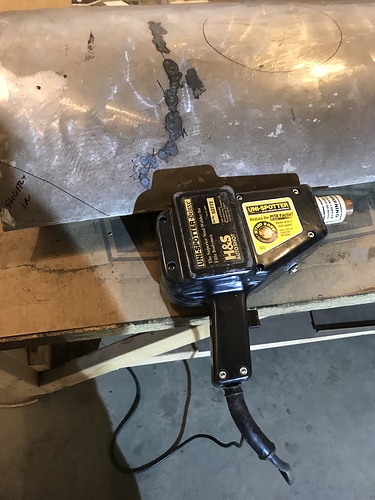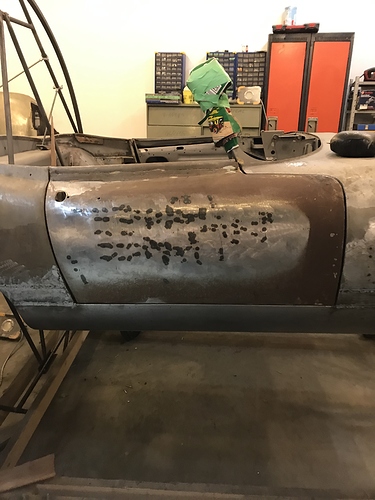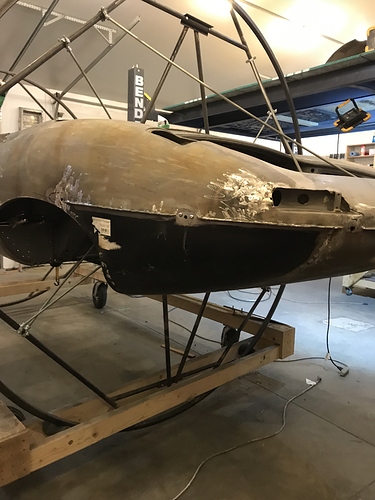What I didn’t do, and this will improve the results is…
I didn’t acid edge the parts before plating. This would have removed the last vestiges of rust. The acid will be toilet cleaner (dilute hydrochloride acid).
In plating, prep is everything. Your parts look better, and your bath stays consistent.
Those are kernals of corn 
Put the car on the lift ready for the old exhaust to come off and the new SS to go on!
Spent the last couple of days welding on my lower rear fenders and reshaping and fitting my doors. Driver side door was not too bad once I got the twist out of it. A few bulges left after the hammer and dolly work. I used a stud welder to shrink them. First time experience with that. Not as fast as oxy-acetylene but much more convenient. The passenger door was much worse. Required a lot of shrinking and it is 1/8 inch too long so it will still require some cutting and welding once the lead work is finished around the door. Starting on the bonnet tomortow. That should be lots of fun!
Deleted as upload failed
Looking real good, Geoff. I like the idea of using the stud welder for shrinking.
Geoff, I cant tell from the pics, are you welding on the stud then grinding off or just zapping it without actually welding on a stud?
Cheers Jim
Yes I am pretty happy with the way it works. I bought it 10 years ago after a little mishap with my (modern) s-type that resulted in a good sized crease in the trunk. No access from the inside because of the support panel and the car was not worth that much so I thought I would give studs a try. It worked well enough to where the trunk was straight enough to slather on the filler and paint it. My son then drove it for a few more years until a tree fell on it and he got a hugely generous insurance payout.
Jim, it is called a stud welder but that is not how it works in this application. There is a small round copper button in the centre and a copper ring around it. You place the electrodes against the panel, press the trigger and a massive current heats a small circle on the panel to red hot. Takes less than a second. Then you quench it and get a minute amount of shrinkage. Keep checking with your straight edge after each shrink. I find that unless you are carefull the tendency is to overdo it. Also make sure that you raise up any depressions in the panel before and as you go alongif at all possible. That is the application where you would weld on studs and then use the slide hammer attachment to pull the depressions up if there is no backside access. Fortunately there is some access in a door as long as you have extra joints in your arms. I have use oxyacetylene before but this is my first time with a stud welder. I find it much more convenient but you do have to proceed slowly because the tool will overheat very rapidly and shut down if you overdo it. It is -25 celsius here so I would set it outside for a few minutes periodically to cool right down.
I sheared the water pump hose adapter trying to replace it.
Any ideas for removing the remaining adapter in the thread?"
Oh Crap! How hard is it going to be to pull the pump? I would start with a hack saw blade (if it fits) and CAREFULLY make 2 cuts then try to peal in the piece I’d cut (just like I would with the rear control arm bushings) with a cold steel chisel.
Just trying to think outside the box, you could use an appropriate sized tap for the opening and tap a thread into the remaining piece for a slightly smaller fitting?
Cheers and good luck,
LLynn
No ideas for doing it in place. But on the bench I’d try a few things. Lots of penetrating oil and time and one of those reverse extraction tools might pop it out. If no go and it’s corroded enough then I’d bore it larger to get rid of some of the meat and pick the remainder out of the threads.
Philip! Weren’t you part of our conversation about this same adapter that goes into the manifold?
If not, here’s the thread on it… same adapter, different location.
-Use a tap without braking it, then put a good bolt in and pull with a crowbar so you can destroy the threads bit by bit (brass is soft, right?). Might expand the tube and make it harder to do… and depending on access. Retap to get out the rest. Unfeasible as the tap will break down there.
-Weld a short bolt to it, try to whack it loose with a very long breaker bar. Also freeze the bolt after warming the pump housing and the brass should contract a little, liberal use of penetrating oil etc. Probably much harder than it sounds.
-Or induction heat the bolt. Brass should get soft at 900°C.
-Ammonia reacts with brass but might not react with iron: put an ammonia soaked rag in there for a week (but make sure I’m not wrong first)?
-Use a dremel instead of a hacksaw. Then chisel out: huge mess. Might work without r&r of the pump.
-Screw extractors and anything for drywall, concrete and so on don’t work as they only expand the tube more before biting enough. (That is what I tried on my dipstick tube, in situ, which is broken off flush with the block; press fit. I was worried about cracking before anything moved). Maybe okay with thicker brass!
-Drill it out. Depending on access. Even on the bench not much fun and you still need to tap. Also, IIRC brass drills must be filed so they don’t bite.
-Cold chisel, then fold the part inwards in a W shape might be your best bet short of removal.
-Other barb or get a machined barb that fits inside would be nice.
My guess is that when you fail at one you’d rather have removed the water pump in the first place…
Yes I was…I just thought Id see if there are any other ideas. I think the cut or drill is the solution
The irony is that the pump was off not too long a go!
I feel for you.
I second the idea of cutting through the wall till you see the thread and then try to collapse the “tube”. It could also make it lose enough to turn it.





